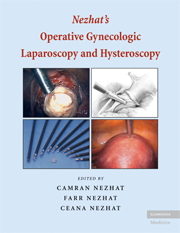Book contents
- Frontmatter
- Contents
- Contributing Authors
- Forewords
- Preface
- 1 HISTORY OF MODERN OPERATIVE LAPAROSCOPY
- 2 EQUIPMENT
- 3 ANESTHESIA
- 4 LAPAROSCOPIC ACCESS
- 5 LAPAROSCOPIC SUTURING
- 6 INTRAPERITONEAL AND RETROPERITONEAL ANATOMY
- 7 FERTILITY
- 8 HYSTEROSCOPY
- 9 MANAGEMENT OF ADNEXAL MASSES
- 10 ENDOMETRIOSIS
- 11 LAPAROSCOPIC ADHESIOLYSIS AND ADHESION PREVENTION
- 12 LEIOMYOMAS
- 13 HYSTERECTOMY
- 14 PELVIC FLOOR
- 15 LAPAROSCOPIC TREATMENT OF CHRONIC PELVIC PAIN
- 16 GYNECOLOGIC MALIGNANCY
- 17 LAPAROSCOPY IN THE PREGNANT PATIENT
- 18 MINIMAL ACCESS PEDIATRIC SURGERY
- 19 LAPAROSCOPIC VASCULAR SURGERY IN 2007
- 20 COMPLICATIONS IN LAPAROSCOPY
- 21 ADDITIONAL PROCEDURES FOR PELVIC SURGEONS
- 22 LAPAROSCOPY SIMULATORS FOR TRAINING BASIC SURGICAL SKILLS, TASKS, AND PROCEDURES
- 23 ROBOT-ASSISTED LAPAROSCOPY
- 24 HYSTEROSCOPY AND ENDOMETRIAL CANCER
- 25 OVERVIEW OF COMPLICATIONS
- Appendix
- Atlas
- Index
13 - HYSTERECTOMY
Published online by Cambridge University Press: 23 December 2009
- Frontmatter
- Contents
- Contributing Authors
- Forewords
- Preface
- 1 HISTORY OF MODERN OPERATIVE LAPAROSCOPY
- 2 EQUIPMENT
- 3 ANESTHESIA
- 4 LAPAROSCOPIC ACCESS
- 5 LAPAROSCOPIC SUTURING
- 6 INTRAPERITONEAL AND RETROPERITONEAL ANATOMY
- 7 FERTILITY
- 8 HYSTEROSCOPY
- 9 MANAGEMENT OF ADNEXAL MASSES
- 10 ENDOMETRIOSIS
- 11 LAPAROSCOPIC ADHESIOLYSIS AND ADHESION PREVENTION
- 12 LEIOMYOMAS
- 13 HYSTERECTOMY
- 14 PELVIC FLOOR
- 15 LAPAROSCOPIC TREATMENT OF CHRONIC PELVIC PAIN
- 16 GYNECOLOGIC MALIGNANCY
- 17 LAPAROSCOPY IN THE PREGNANT PATIENT
- 18 MINIMAL ACCESS PEDIATRIC SURGERY
- 19 LAPAROSCOPIC VASCULAR SURGERY IN 2007
- 20 COMPLICATIONS IN LAPAROSCOPY
- 21 ADDITIONAL PROCEDURES FOR PELVIC SURGEONS
- 22 LAPAROSCOPY SIMULATORS FOR TRAINING BASIC SURGICAL SKILLS, TASKS, AND PROCEDURES
- 23 ROBOT-ASSISTED LAPAROSCOPY
- 24 HYSTEROSCOPY AND ENDOMETRIAL CANCER
- 25 OVERVIEW OF COMPLICATIONS
- Appendix
- Atlas
- Index
Summary
The number of hysterectomies, a frequently practiced major surgical procedure, varies between different regions and cultures of the world. It reflects differences in health care systems, education, and psychosocial attitudes. The highest rates of hysterectomy are found in the United States and Australia (36% and 40%, respectively) and the lowest in Italy (15.5%) and France (8.5%).
INDICATIONS
Most hysterectomies are performed for leiomyomas, uterine prolapse, endometriosis, and gynecologic cancer. The number of hysterectomies for endometriosis doubled between 1965 and 1984, exceeding the increase observed for any other indication and probably reflecting an increased recognition of endometriosis. Other indications are abnormal uterine bleeding, pelvic infection and its sequelae, ovarian tumors, and complications of pregnancy. These indications account for 15% to 21% of all hysterectomies.
About 75% of all hysterectomies are done abdominally and 25% vaginally. The vaginal approach is primarily used for uterine prolapse. Abdominal hysterectomy is usually done for women with significant pelvic disease, such as endometriosis or pelvic adhesions, which can make a vaginal removal more difficult (Table 13.1.1). Compared to those having a vaginal hysterectomy, women having an abdominal operation have more febrile morbidity, receive more blood transfusions, and have a longer postoperative hospitalization and convalescence. If more women had a vaginal rather than an abdominal approach for their hysterectomy, therapeutic, economic, and social benefits would result.
- Type
- Chapter
- Information
- Nezhat's Operative Gynecologic Laparoscopy and Hysteroscopy , pp. 341 - 365Publisher: Cambridge University PressPrint publication year: 2008

